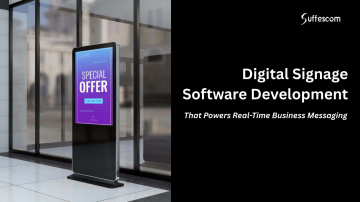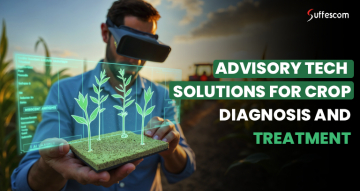Wear OS App Development Solutions | Android Wear OS App Cost

In today's hyper-connected world, wearable technology has transitioned from a novelty to a strategic business platform. The wearable OS has garnered attention in the tech space. It is built specifically for smartwatches and other wearables, and provides a compelling proposition for businesses to deepen their digital presence beyond the smartphone. There is no doubt about the fact there are millions of active devices existing globally, due to which there is an increased user interest in on-the-go connectivity. Building a Wear OS app enables brands to interact with users in more intimate and instant ways.
Looking from business lens, Wear OS application development provides access to a new generation of micro-interactions, fast, glanceable notifications, contextual reminders, and simple task completion. Wear OS supports standalone apps to be used without a smartphone, offering potential for app monetization, subscription models, and more active users. Google Ecosystem integration adds even greater business value, enabling seamless access to user context information.
Investing in Wear OS app development is not merely about matching innovation, it's about bringing value where customers need it most: fast, easy, and relevant. For businesses committed to improving customer experience, growing platform presence, and remaining competitive, Wear OS is a worthwhile step ahead.
What is a Wearable OS App, and How Does it Work?
It is an app software installed on wearable devices like smart devices. These provide hands-free and instant interactions aimed at navigation, health tracking, and notifications, among other uses. Wearable OS apps are highly optimized for the small screens and minimal input, which helps increase user convenience and displays all services directly on the user's wrist.
Working Model
- User downloads and installs the app through the Play Store
- For the startup, the app requests permission, such as access to the location.
- User interaction is developed through touch or swiping.
- The wearable OS app utilizes hardware sensors to acquire real-time data.
- Data is synchronized over Bluetooth, Wi-Fi, or LTE and is paired to the phone with a data layer API.
- The notifications and the alerts are shown even when the screen is off.
- The application provides mini-widgets on the watch face and full-screen tiles for convenience.
- Additionally, the app is Google Services integrated and can leverage Google Fit, Assistant, Maps, and other APIs to boost its features.
Wear OS App Development Services: Your Business, One Tap Away!
Next-Gen Smartwatch Apps with Our Wear OS Development Services
Hire a leading Wear OS app development company that will offer end-to-end services, helping build performance-driven and intuitive apps optimized for smartwatches running on Google’s Wear OS platform.
1. Consultation Services
Whether building from scratch or looking to improve a current solution, our experts provide strategic suggestions for maintaining platform compatibility, user experience design, performance optimization, etc.
2. Custom Wear OS App Design
Craft tailored Wear OS app designs with intuitive interfaces, seamless navigation, and smartwatch-optimized user experiences for enhanced engagement and usability.
3. Android App Development
Leverage Wear Android app development services, which ensure that the smartwatch app is responsive, robust, feature-rich, follows Google guidelines, and is smoothly integrated within Android smartphones and tablets.
4. IoMT Integration
Involves linking with medical devices, health monitoring sensors, and EHR systems to gather, process, and send vital patient information in real-time.
5. IoT & Smart Home Integration
From syncing with health APIs to integrating fitness tracking platforms and payment gateways, we provide secure, real-time data flow and interoperability that add value and improve the user experience.
6. Continuous Support
With non-stop support and maintenance services, we make sure your Wear OS app remains secure with full version updates and in full functionality as the platform continues to grow.
7. Voice Support
Our voice support solutions let the app be controlled with hands-free functionality, enhancing accessibility and building natural, conversational experiences on Wear OS devices.
8. Sensor Data Utilization
Harness the full potential of smartwatch sensors such as heart rate monitors, accelerometers, gyroscopes, and ambient light sensors to deliver real-time, context-aware features. This enables activity tracking, motion detection, sleep analysis, and personalized health insights, creating smarter and more responsive Wear OS applications tailored to user behavior.
Wear Android App Development: Features Enhancing Performance
App development for Wear OS comes with distinctive features that improve productivity and enhance accessibility.
1. Offline Functionality
Wear OS apps enable offline capability, which keeps users able to access basic features even without internet connectivity. From looking at cached fitness information, accessing navigation capabilities, or playing stored media, offline capability allows the app to function during travel or in low-connectivity zones.
2. Mobile Integration
Wear OS applications are designed in collaboration with Android smartphone applications. The data is exchanged between different devices, enabling users to start an activity on their smartwatch and resume it on their phone.
3. Gesture and Touch Controls
Optimized for smaller screens, Wear OS apps employ intuitive touch and gesture-based navigation. Users can swipe, tap, and rotate bezels (available on certain devices) to cycle between menus, see details, or take action with ease. This provides a smooth, intuitive experience optimized for wearable devices.
4. Real-Time Messages
Provides timely notifications on the user's wrist, reminding them with messages and updates. From calendar reminder to social media update or breaking business news headline, Wear OS apps display the information without needing a glance at the phone.
5. Health Tracking
Helps set fitness goals and tracks progress simultaneously with real-time biometric feedback. The Android development for Wear OS helps monitor the heart rate, steps, workouts, and even the stress levels with utmost precision.
- Activity Tracking – Steps, distance, calories burned, floors climbed.
- Workout Monitoring – Real-time stats for running, cycling, gym, yoga, etc.
- Heart Rate Monitoring – Continuous or spot checks.
- Sleep Tracking – Detect sleep stages, duration, and quality.
- Blood Oxygen (SpO2) – Wellness tracking with oxygen saturation.
- ECG & Stress Detection – Heart rhythm and stress levels.
6. Voice Commands & Assistant Integration
Integrated with Google Assistant, the app allows users to operate apps with voice commands. With voice integration, the usability is enhanced along with ease of use, as no physical interaction is required.
7. Custom Watch Faces
Offers personal watch face options that show live data, including fitness data, weather, calendar events, or app-specific data, on the watch face screen. The apps hold vital data within and provide easy access throughout the day.
App Development for Wear OS: Step-by-Step Guide
As a reliable Wear OS app development company, we have extensive experience in Wear OS app development for iOS and Android, delivering a seamless and functional user experience on smartwatches.
1. Development Environment Set Up
This step involves installing the latest version of Android Studio. Moreover, an emulator needs to be installed for testing or have access to a physical Wear OS device. Setting up your environment also means configuring your project to target Wear OS by using proper dependencies. This environment allows you to code, debug, and test efficiently.
2. User Interface for Diverse Screens
Wear OS apps require a UI design that accommodates small, circular, or square screens. This involves using simplified layouts, larger touch targets, and optimized navigation patterns to enhance user experience. It's also important to consider different screen shapes and sizes by using constraint layouts and preview tools. The goal is to deliver a user-friendly experience that suits quick interactions on wearable devices.
3. Feature Implementation
Core feature integration in a Wear OS app involves implementing the primary functionalities that define the app's purpose. This includes accessing sensors like heart rate, step counter, or GPS using Android APIs. Developers must ensure efficient data processing and minimal battery usage. Core features should align with the wearable experience, i.e, quick, glanceable, and context-aware. Proper integration also involves handling permissions, background tasks, and UI responsiveness to deliver a seamless and functional user experience on limited hardware resources.
4. Testing
This is an important step to follow as accessing the app's performance on emulators and real devices ensures the Wear OS app works perfectly across various screen sizes. Emulators simulate round, square, and different resolution watches, helping identify UI and compatibility issues early. Comprehensive testing guarantees a smooth user experience and prepares the app for successful deployment across diverse Wear OS devices.
5. Performance Optimization
It is crucial to optimize for battery and performance due to limited device resources. The use of monitoring tools in Android Studio helps track CPU, memory, and battery usage. The developers reduce background processing and utilize effective algorithms that ensure smoother performance, leading to superior user satisfaction across all Wear OS devices.
6. App Submission
The final step is to prepare your Wear OS app for release. It needs to be ensured that the app works seamlessly with all functionalities intact. Before submission, Google's quality guidelines for Wear OS apps need to be followed, which improves the chances of approval . Once submitted and approved, the app is available for download on compatible Wear OS devices.
App Development for Wear OS: Use Cases Across Industries
Harness our Wear OS app development services and build a robust application that serves its use cases in multiple industries, some of which are illustrated below;
1. Healthcare
Wear OS apps monitor vital signs, track physical activity, and promote healthier lifestyles. Such apps help users achieve fitness goals and manage chronic diseases. For healthcare providers, it facilitates remote patient monitoring with real-time feedback.
2. Transportation
Wear OS applications keep workers in touch with real-time notifications of tasks, delivery routes, and statuses. Drivers or delivery staff may be sent alerts, directions, or traffic information without checking their phones.
3. Retail
The shopping experience of the customers is absolutely improved as they get hands-free alerts on the rewards and order status. The operations are automated concerning the inventory management, enabling retailers to offer personalized, and convenient shopping experience to the users.
4. Travel and Hospitality
The guest experience is enriched as customers and guests get check-in reminders, room service notifications, and personalized offers straight on their smartwatches. Travel-related apps offer boarding passes, gate change notifications, itinerary updates, and language translation capabilities, all of which are just a glance away.
5. Banking
Wear OS apps provide customers with up-to-date details regarding account balances, transaction alerts, stock prices, and payment reminders. Biometric verification and minimal screen touch, Wear OS apps provide easy and secure mobile banking services with the ability to control their finances everywhere, anytime.
Build Next-Gen Android Wear OS App Today!
Top Reasons Businesses Want to Invest in Wear OS App Development
Venturing into a new business is always challenging. Only the trustworthy Wear OS app development company has the potential to help you boom in the wearable market with ample opportunities and gain customer loyalty.
1. Competitive Advantage
Wearable OS app development positions a company as a leader in its field. By adopting cutting-edge technology, organizations excel over the competition, engage technologically savvy customers, and project a brand image of being pioneers. This differentiation leads to increased revenue, brand loyalty, and enhanced market presence .
2. New Revenue Streams
Wearable OS applications provide new revenue opportunities. Businesses can offer premium functionality, subscription plans, or in-app items tailored to the wearable UI. Data collected from wearables can further be utilized for generating targeted marketing campaigns.
3. Improved User Engagement
App development on wearable OS provides businesses with an unprecedented way to interact with consumers in real-time. Mobile apps lack the immediacy of providing instant access to notifications, health information, and personalized content on the wearer's wrist in real time. Constant connectivity fosters increased user engagement.
4. IoT integration
Wearables OS apps tend to be part of a larger IoT ecosystem that provides effortless integration with other smart devices. This connectivity makes synchronized actions possible, including integration with other devices within a home automation setting. Interconnectedness maximizes convenience for users and creates potential for innovative services.
5. Data Accumulation
With the Android storage API and the Wear OS Data Layer, large sets of data are collected and synchronized between devices. The valuable insights, like user habits and preferences, are analyzed to make accurate decisions.
How Much Does it Cost to Build a Wear OS App?
App development for Wear OS typically costs $ 8,000-$ 25,000. The budget may exceed due to specific parameters, such as the app's complexity, features, and development approach.
1. App Complexity
One of the major cost drivers in wearable OS development is the level of complexity involved. The basic app costs much less than the mid-level and advanced apps. Moreover, the use of cutting-edge technologies and tools like AI analytics makes the apps expensive.
2. UI/UX Design
The interactive interfaces, voice assistant integration, visually appealing elements, and animated interfaces require a hefty budget.
3. Development Team Location
The developers residing in North American and European regions tend to charge more as compared to those in Asian and Middle Eastern areas. The cost difference is massive as the US company charges triple that of any Asian country.
Why is Suffescom the Best Wear OS App Development Company?
Suffescom is the leading custom wearable device app development company, assisting businesses in building scalable applications for smartwatches, glasses, and fitness bands. Peek through the following pointers to get a glimpse of why we are the best in the market.
1. Versatile Portfolio
Our team has built wearable apps across diverse sectors with clients like NBC, Universal Pictures, Chili’s, catering to every client's requirements.
2. Latest Technologies
Our developers use ultra-modern technologies such as AI, AR, and VR, which assist in the development of future-proof wearable apps.
3. Transparency
Suffescom is providing transparent price policy, free consultation, and no concealed cost, providing long-term faith and loyalty.
4. Timely Delivery
We adopt agile methodologies that help in successful project delivery within or even before the app development timelines without hampering performance.
5. Customer Support
Our team offers 24*7 tech support services to the clients while addressing and resolving the issues on time.
6. Customization
We provide tailored solutions to businesses while crafting a unique app that suits their business requirements.
FAQs
1. How much time does it take to build a Wear OS app?
The time taken for app development for Wear OS is usually 4-6 weeks, based on the project complexities.
2. What languages are used in app development for Wear OS?
Java and Kotlin are the most commonly used languages to build the app with ultra-modern features.
3. How is the Wear OS app tested for interactions?
The Android emulator, Wear OS emulator, and pairing assistant are responsible for checking and evaluating the interactions between smartphones and watches.
4. Which tech stacks are used in the Wear Android app development?
Android Studio, Retrofit, Google Play Console, Tiles API, and Jetpack Compose are the most popular tech stacks used in the Wear Android app development process.
5. What is Wear OS and why should my business invest in it?
Wear OS is Google’s operating system that allows real-time, hands-free interactions. Investing in Wear OS will make businesses more capable of attracting customers, providing them instant services, and staying ahead in the wearable tech market.
6. Which devices will my Wear OS app run on?
The Wear OS app has very high compatibility with a variety of smartwatches from brands like Google (Pixel Watch), Samsung (Galaxy Watch), Fossil, and Mobvoi TicWatch, ensuring broad compatibility and reach.








